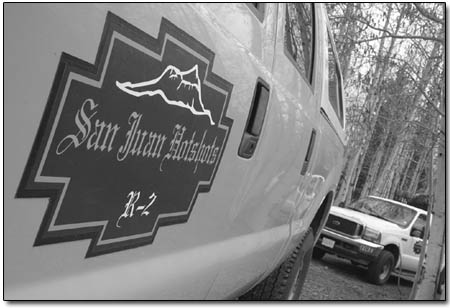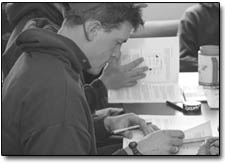 |
| A San Juan Hotshots vehicle
sits in front of the crew’s headquarters just above
Cascade Village, near the base of Engineer Mountain. The
elite team is training for another season of wildland firefighting./Photo
by Todd Newcomer |
Some unlikely spectators watched
last year as a wildfire consumed thousands of acres on Missionary
Ridge. Stationed at the base of Engineer Mountain, the 20-member
San Juan Hotshot Crew could only fretfully watch and listen
to the fire as it erupted day and night, destroying landscape
and homes.
At the time, the newly established crew was enduring seven
weeks of required training. Crewmembers were still spending
hours on end swinging Pulaskis, learning about fire behavior
and training their bodies for extreme outdoor conditions. At
the end of long days, the hotshots retreated to their homes
– some near the fire and some in the fire’s path
– only to watch it burn with great intensity. Their Pulaskis
lay abandoned at their Engineer Guard Station.
For the seasoned firefighters, waiting to fight the fire was
a logical decision based on wisdom and safety. For the novices,
waiting to fight the fire was like waiting for Christmas morning.
It was difficult for everyone.
“I had to hide my feelings of anxiety that the fire was
going on,” says Hotshot Superintendent Shawna Legarza.
“I knew what had to be done before we could go fight the
fire.”
Soon, though, training was over, and the 20 crewmembers finally
converged on the Missionary Ridge Fire and fought it with lessons
fresh on their minds and the eagerness required of wildland
firefighters. It was, literally, a trial by fire.
Leading the elite
Now, back for a second year, the San Juan Hotshot Crew is settled
in and prepared for this year’s wildfire season. All but
five hotshots from last year returned, giving the crew a range
of experience – from brand-new firefighters to veteran
firefighters with 15 years of experience. To boot, their leader,
Legarza, is the only female superintendent of a hotshot crew
in the country – and is only the third female superintendent
in the history of hotshot crews.
And along with varying years of experience, each has his or
her own story about joining what is known as the “elite”
crew of wildland firefighters. There is one common thread among
the San Juan Hotshots, though. Nearly every one grew up learning
to love – by choice or not – physical labor in the
outdoors.
Take Joe Wyatt, a farm boy from the Idaho Panhandle. For 10
years, he has worked in various firefighting jobs, mostly on
helitack crews. Spending his youth working on a farm and doing
logging, Wyatt has always found more enjoyment working outside,
where he’s pushed to his physical limit.
Then there’s Jacob Birdsell, who is entering his second
season as a wildland firefighter. Birdsell, another farm boy,
grew up in Jewel, Kans. While growing up, Birdsell’s family
home was destroyed by fire started from an electrical short.
“That’s what got me first interested in fire,”
Birdsell says. Add to that his love of the outdoors and the
zest for physical labor.
Jesse Jones was going to fire camp when he was as young as
three years of age. His parents worked for the Forest Service,
often in fire-suppression positions. Growing up in the Cascade
Mountains of Oakridge, Ore., Jones was enveloped with lush forests
– and the fuels that would ignite them. In his eight years
as a firefighter, Jones has climbed the ladder, from working
on hand, rappelling and helitack crews, to his current stint
as a hotshot. Though he was immersed in a firefighting atmosphere,
Jones said he wasn’t pressured by family to do this type
of work. “My family expected me to find happiness. And
I found happiness in fire,” he says.
Arduous work
Along with his crewmembers, Jones says happiness as a hotshot
comes in several ways. But none of it is found in the glory
of being labeled “elite.” People have tagged hotshots
as the cream of the crop, because they are the most physically
fit firefighters, expected to be self-sufficient in the most
grueling and demanding positions.
Hotshots typically work 14-day shifts, with two days off in
between, and often work up to 16 hours each day. When they aren’t
fighting fires, they spend 1BD hours physically training each
day. To become a hotshot, applicants must pass a “pack
test,” which requires completing a three-mile hike in
45 minutes or less carrying a 45-pound pack.
In addition, they have to prove their fitness by running 1BD
miles in less than 10:35, and do 40 sit-ups in 60 seconds, 25
push-ups in 60 seconds and a certain amount of pull-ups depending
on individual body weight.
The fitness helps hotshots remain at the top of their form,
because when a wildfire breaks out, they have to hike backcountry
terrain carrying all of their equipment, food and water. They
work on the frontlines of a fire, digging fire lines and enduring
searing heat, hard sleeping ground and few amenities.
 |
Hotshot Lance Martin, of Kansas,
flips through a training workbook in preparation
for the upcoming firefighting season./Photo
by Todd Newcomer. |
Though the San Juan Hotshots are located on the San Juan National
Forest, they fight fires anywhere in the country when needed.
They often spend several weeks away from home, fighting one
fire after another in unpredictable environments.
Still, most members of the San Juan Hotshots refuse to soak
up what they see as fulsome praise.
“‘Elite’ is a strong word,” says Ray
Gething, a three-year firefighter. Dustin Davison agrees. “As
a hotshot, we definitely see a lot more fire. But it’s
the crews who do the cleaning up after us that do the real dirty
work.”
Recognizing the pedestal many put hotshots on, Legarza makes
an effort to keep her crew grounded. Part of that requires her
to ensure good team dynamics – and sound logistics.
“People call us the elite because our system is so organized
and we easily adapt to different environments. We pride ourselves
on being good in any situation,” she says. “But,
I don’t want my crew to have an ego. I don’t think
we are the elite, we’re more like the backbone.”

